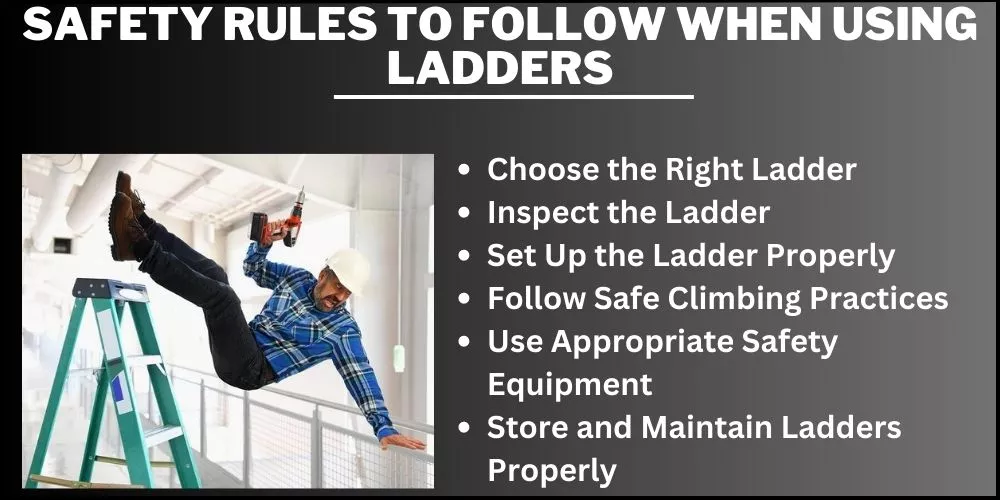Climbing a ladder may seem simple, but ensuring safety is paramount. One crucial aspect of ladder safety is maintaining the appropriate contact points during ascent, descent, and while working at height.
So, how many points of contact on a ladder is recommended?
Ideally, you must maintain 3 points of contact at all times to ensure safety and stability of your ladder.

However, this article will delve into the importance of points of contact on a ladder, the recommended number, and tips to maintain stability and minimize the risk of accidents in a detailed manner.
Whether you’re a DIY enthusiast or a professional tradesperson, understanding the proper use of a ladder can make all the difference in preventing falls and injuries.
How many points of contact on a ladder?
When using a ladder, it is essential to maintain three points of contact at all times to ensure safety and stability. This means that while climbing or descending, you should have either two feet and one hand or two hands and one foot in contact with the ladder.
Maintaining three points of contact minimizes the risk of losing balance and falling, as it provides adequate support and control.
It is also important to remember that while working at height, you should not overreach or lean too far to the side, as this can compromise your stability and increase the risk of accidents. Always prioritize safety and use the appropriate ladder for the task at hand.
Importance Of 3 Points Of Contact Rule
Climbing a ladder may seem straightforward, but it can quickly become hazardous if proper safety measures are not taken. The 3 points of contact rule ensure safe ladder usage, reducing the risk of falls and injuries.
In this section, we will explore the importance of this rule in detail.

🪜Enhanced Balance and Support
Maintaining three points of contact at all times gives your body the necessary support and balance to safely move up and down the ladder. This reduces the risk of slipping or losing your grip, possibly leading to a fall.
🪜Reduced Fatigue and Overexertion
Climbing a ladder can be physically demanding, especially when carrying tools or equipment. The 3 points of contact rule help distribute your body weight evenly, reducing the strain on your muscles and joints.
This can minimize the risk of fatigue and overexertion, which could compromise your safety.
🪜Improved Focus and Awareness
Following the 3 points of contact rule requires conscious effort and attention, which fosters a greater sense of focus and awareness while using a ladder. This heightened awareness can help you avoid hazards and make safer decisions when working at height.
🪜Compliance with Safety Regulations
Adhering to the 3 points of contact rule is a best practice for ladder safety and a requirement in many occupational safety regulations. Following this rule demonstrates compliance with these regulations and a commitment to maintaining a safe work environment.
🪜Prevention of Accidents and Injuries
Ultimately, the primary goal of the 3 points of contact rule is to prevent accidents and injuries. Ladder-related incidents are a leading cause of workplace injuries, and maintaining three points of contact is a proven method to reduce the risk of falls and associated consequences.
In conclusion, the 3 points of contact rule is an essential aspect of ladder safety that should not be overlooked. Adhering to this rule can significantly reduce the risk of accidents and injuries, ensuring a safer and more productive work environment.
Safety Rules To Follow When Using Ladders
Using a ladder may seem simple, but it can lead to serious injuries if proper safety precautions are not followed. Consider these important safety rules to ensure your safety while using a ladder.

🪜Choose the Right Ladder
Selecting the appropriate ladder for the job is crucial for your safety. Consider the following factors when choosing a ladder:
- Height: Ensure the ladder is tall enough to reach the desired height safely.
- Weight Capacity: Check the ladder’s maximum weight capacity, including your weight and any tools or materials you will carry.
- Material: Choose a ladder made from a material suitable for the job. For example, use a non-conductive fiberglass ladder when working near electricity.
🪜Inspect the Ladder
Before using any ladder, perform a thorough inspection to identify any potential hazards:
- Check for loose or damaged rungs, rails, or braces.
- Ensure all bolts and rivets are secure.
- Look for any signs of corrosion, cracks, or other damage.
- Confirm that safety feet and other non-slip features are in good condition.
🪜Set Up the Ladder Properly
Proper ladder setup is essential for maintaining stability and preventing accidents:
- Place the ladder on a level, firm surface.
- Open the stepladders fully and lock the spreaders in place.
- For extension ladders, follow the 4-to-1 rule: For every four feet of height, move the base of the ladder one foot away from the wall.
- Secure the ladder’s top and bottom to prevent movement.
🪜Follow Safe Climbing Practices
When climbing and working on a ladder, adhere to these safety practices:
- Maintain three points of contact (two hands and one foot or two feet and one hand) at all times.
- Face the ladder while climbing and working.
- Do not overreach or lean too far to one side; reposition the ladder as needed.
- Keep your body centered between the side rails of the ladder.
- Never stand on the top two rungs of a stepladder or the top three rungs of an extension ladder.
🪜Use Appropriate Safety Equipment
Depending on the ladder type and the job requirements, additional safety equipment may be necessary:
- Wear slip-resistant shoes or boots.
- Use a tool belt or rope to keep tools and materials within easy reach.
- Consider using a ladder stabilizer or leveler for added stability on uneven surfaces.
- For extension ladders, consider using a ladder standoff to prevent damage to gutters or other surfaces.
🪜Store and Maintain Ladders Properly
Proper storage and maintenance are essential for ensuring the longevity and safety of your ladder:
- Store ladders in a dry, well-ventilated area away from direct sunlight and extreme temperatures.
- Keep ladders clean and free of debris, oil, or grease.
- Regularly inspect and maintain ladders according to the manufacturer’s guidelines.
Following these safety rules can significantly reduce the risk of accidents and injuries when using ladders. Remember to always prioritize safety and never take shortcuts when working at heights.
frequently asked questions (FAQs)
How many points of contact should a person always have on a ladder?
Answer: A person should always maintain three contact points on a ladder. This means having two hands and one foot or two feet and one hand in contact with the ladder to ensure stability and reduce the risk of falling.
What is the 4 to 1 rule for ladders?
Answer: The 4 to 1 rule for ladders is a guideline for setting up an extension ladder at a safe angle. For every four feet of ladder height, the base should be placed one foot away from the wall or support surface. This helps maintain stability and prevent the ladder from tipping backward.
What is the 3 point contact rule?
Answer: The 3 point contact rule refers to maintaining three points of contact with a ladder at all times while climbing or working. This means keeping either two hands and one foot or two feet and one hand in contact with the ladder to ensure stability and minimize the risk of falling.
What are 2 rules of ladder safety?
Answer: Two important rules of ladder safety are: 1) Choose the right ladder for the job, considering factors like height, weight capacity, and material, and 2) Set up the ladder properly, placing it on a level, firm surface, and securing the top and bottom to prevent movement.
How many points of contact on a mobile ladder?
Answer: Just like with stationary ladders, a person should always maintain three points of contact on a mobile ladder. This means having either two hands and one foot or two feet and one hand in contact with the ladder to ensure stability and reduce the risk of falling.
Conclusion:
In conclusion, maintaining three points of contact on a ladder is a vital safety measure that should never be overlooked. Whether using a stationary or mobile ladder, adhering to this rule ensures stability, minimizes the risk of falling, and promotes a safer working environment.
As part of a broader commitment to ladder safety, always choose the right ladder for the job, set it up properly, and follow best practices while climbing and working at heights.
Doing so can greatly reduce the potential for accidents and injuries, ultimately ensuring a more secure and productive experience when using ladders.


